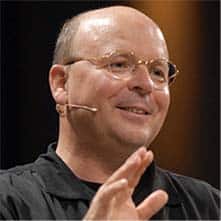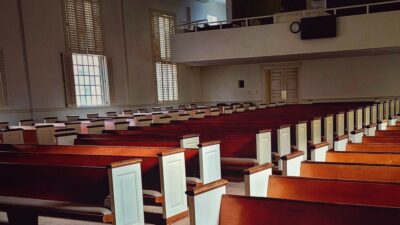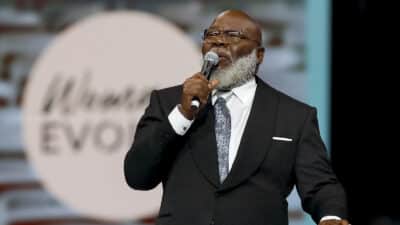For a growing percentage of U.S. adults, going to church is not part of their experience. It’s not that they rarely attend, but that they never walk through the church doors.
For the first time in the history of the General Social Survey (GSS), more than 1 in 3 Americans say they never attend religious services.
One of the largest sociological studies in the country, the GSS has been tracking the beliefs and behaviors of U.S. adults for more than 50 years. In the latest survey, 34% say they never attend a religious service, up from 31% in 2021.
Additionally, for the first time, those who never attend church outnumber those who regularly attend. Slightly fewer than a third (32%) of Americans say they attend religious services at least monthly.
U.S. adults are essentially divided into thirds according to their connection with a local congregation. One-third never attend; one-third sporadically attend; and one-third regularly attend. Specifically among those who have a tenuous connection with a church, 11% attend less than once a year, 13% attend once a year, and 10% attend several times per year.
Your tax-deductible gift helps our journalists report the truth and hold Christian leaders and organizations accountable. Give a gift of $30 or more to The Roys Report this month, and you will receive a copy of “Baptistland: A Memoir of Abuse, Betrayal, and Transformation” by Christa Brown. To donate, click here.
Among those with regular religious service attendance, 4% attend monthly, 5% attend two to three times a month, 4% attend nearly every week, 13% attend weekly, and 5% attend more than weekly.
5 groups most likely to never attend
Not every demographic in the U.S. is staying away from religious services, but some specific segments are more likely to say they completely avoid church.
Young adults
Two in 5 adults under age 35 (40%) say they never attend religious services. While it may have been common in recent years for churches to be missing younger adults, that age range wasn’t always an outlier. As recently as 2004, across every age demographic, the percentage who never attended was within 2 percentage points of each other, ranging between 15% and 17%.
In recent decades, however, the rate of younger adults never attending church has accelerated, while the percentage among older groups has continued increasing but at a slower rate.
Lifeway Research found 66% of Americans who attended church regularly for at least one year as a teenager eventually dropped out of church for at least one year as a young adult. Some of those who are never attending used to be an active part of a local church.
Lower- and working-class Americans
Churches are increasingly losing Americans who see themselves as lower or working class. In 2022, almost half of self-identified lower-class Americans (47%) said they never attend religious services, a 14-point jump from the 33% who said so in 2021. Among working-class adults, 35% say they never attend. Meanwhile, 30% of the middle class and 24% of the upper class say they never attend religious services.
Similar trends exist with education levels; 42% of Americans with less than a high school diploma, 36% of those with a high school education, and 28% with a college degree say they never attend church.
Never married
Two in 5 Americans who have never been married (40%) say they never attend religious services. As churches are often geared toward families, those who have only ever been single may feel as if congregational life is not for them.
Previously, similar percentages of never-married and divorced adults said they never attended church, but that began to shift around 10 years ago. Since then, the percentage of divorced adults who never attend has ranged from 29% to 33%. Meanwhile, the percentage of never-attending never-married adults has steadily grown from 32% to 40%.
Those who are married (30%) or widowed (31%) are the least likely to say they never attend.
Non-Republicans
No partisan gap in church attendance existed through the mid-90s. More independents regularly said they never attended, but Republicans and Democrats reported similar non-attendance rates until 1996, after which the two parties began to pull apart in the pews.
Independents (38%) remain the most likely to say they never attend church, followed closely now by Democrats (35%). Republicans (22%) are the least likely to say they never attend church. The partisan gap could be accelerating based on churchgoers increasingly saying they want to attend a church where people share their political views, according to a 2022 Lifeway Research study.
Men
Today, more than 38% of men say they never attend religious services, compared to 30% of women. A gender gap in the pews is not necessarily unique. Only once in the history of the GSS have women been more likely than men to say they never attend—1976, 13% of women and 11% of men.
However, the gap between men and women in 2022 represents the largest ever in GSS. In 2021, the deficit had narrowed to 2 points (32% v. 30%), but a spike among men stretched the gap to eight percentage points.
This article was originally published on LifewayResearch.com and has been reprinted with permission.
Aaron Earls is the senior writer at Lifeway Research.





















8 Responses
“Slightly fewer than a third (32%) of Americans say they attend religious services at least monthly” counts for regular attendance?
I think Lifeway has substantially lowered the bar if those claiming monthly attendance are now considered “regular churchgoers”. Monthly attendance would have been seen as sporadic when I was a kid.
One take on the statistics reported here. Namely that the congregational or social aspect of being Christian, is weakening. Such that the basis for being Christian is changing towards personal/individual understanding of the Bible and its thesis.
The “church” (representative body of Christ on Earth) is then being seen in two ways. Classically or traditionally as a congregational institution (here measured by “church attendance”). Currently or progressively, as a personal understanding.
Arguably any movement from congregational institution to personal understanding, appears strongly connected to changes in wider societal conditions. Here, Democrats who lean progressively into such change, may be moving to understanding. While Republicans who lean into opposition to those same changes, cleave to congregational Christianity, and indeed are harnessing that congregational Christianity (that Church) politically, to extend the social conditions of their Church and Party into bringing social conditions back in line with their Christian beliefs and faith.
The situation with younger cohorts appears to be one of change the Church or lose many from Christianity. Is prevailing Christianity mobile and lithe enough to travel with the individuals of this cohort. The signs there are mixed. Arguably the current schisms within Christianity, reflect those whose belief/faith allows them to go to where this younger cohort are to be found, while the belief/faith of others sees them needing this cohort to “come back” to where they stand doctrinally and theologically.
My own sense is, that Congregational Christianity will decline numerically, while becoming more fundamentalist as this decline occurs; so survival there, for that model of the “body of Christ”. While Christianity emerging from personal/individual “understanding” (so something of a Protestant stream of Christianity), might increase in number of adherents, but diversely so, and perhaps across fairly constant coming together and moving on dynamics. Where, in this latter instance, the umbrella nature of the body of Christ becomes a never-ending process of understanding. The key to health in this latter instance, being respectful toleration across the diversity of understanding emerging.
The other open question is how many of the people who do go to church are really committed to it, as opposed to going for cultural reasons, networking reasons, and family expectations. I have a theory that half the men in the pews are there because the women in their lives pressure them to go.
“11% attend less than once a year”
How is it possible to attend less than once? Isn’t once the least you can attend? What would 1/2 of once be, driving into the parking lot and turning around?
That made me smile. Thank you for that.
Presumably the less than once a year, might cover people who attend fewer times than the number of years considered. So, for example, twice in three years, or once in two years, or x-times in x+1 (or more) years.
There is no religion in the Body of Christ.
One of our church officials announced to our Sunday School that we could either agree to sing Hillsong and Bethel Redding music in church or we could find the door.(This was after the scandals broke.) My last day at Galesburg Bethel.